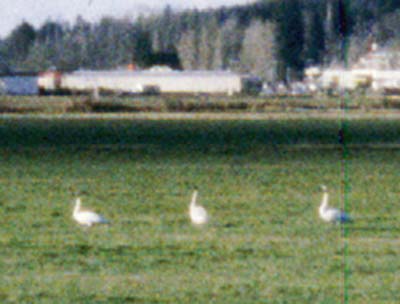wildlife and mini-malls
My friend Laura was riffing about stumbling on a show about the wildlife of Israel, while channel surfing for news on the Iraq war. These shows always seem to frame what appears to be pristine nature, without showing the post-industrial context. I am reminded of this whenever I drive down to the Comox Valley (Vancouver Island British Columbia), in the winter. Right next to the big box stores and the light industrial parks of the’ Edge City sprawl, lie a few lush fields which constitute the main wintering ground of the endangered trumpeter swan, the largest waterfowl on earth. There’s something deeply sad about seeing the trumpeters graze away against a backdrop of mini-malls and ‘U-store it’ units. One could easily film them without this context, but it would be a lie. It’s important to cop to understanding that a large proportion of the winter habitat of one of the most threatened and beautiful water birds on the planet is basically a part of Late Capitalist suburbia. Here is a somewhat grainy pic of a group of trumpeter swans from out the car window:
 .
.
Nature shows such as “Mutual of Omaha’s” Wild Kingdom where a staple of my childhood television experience. Unfortunately many of the shots in such shows were ‘set up’, inflicting considerable cruelty and suffering on the animals being filmed. The quintessential example of this is the 1958 film, ‘White Wilderness,’ in which lemmings were basically shovelled off of a precipice to reinforce the (erroneous) idea that they habitually commit suicide. The Nature magazine website debunks this myth and provides valuable insights into lemming behaviour. It turns out that we humans have a lot in common with them, especially around election time.
The most egregious ‘mockumentary’ filmmaking was of course perpetrated by Disney. There is a great article in Earth Island Journal by Chris Clarke, describing how Disney has misinformed generations of North American children on how animals actually interact with each other and with their environment.
While this fiction is understandable in its cartoons, Disney’s use of authentic seeming wildlife documentaries to reinforce the cornerstones of capitalist myth such as social Darwinism and erroneous notions of ecology as personality cult, continues to be pervasive.
Cougars or mountain lions frequent the island on which I live. Vancouver Island is one of the world centres for cougar population, but you rarely see them. One is lucky to catch a few glimpses in an average lifetime. My glimpse was out of my truck window around 8 o’clock at night on a rainy, winding road. The enormous cat jumped out of the darkness with all of the ease of a kitten jumping off of an armchair and into the pool of my headlights. Within an instant, it was gone. This fleeting, yet authentic experience gave me far more of a ‘frisson’ than any wildlife documentary ever could, despite and in fact, because of its evanescence. Through its overexposure in the Disnified world of ‘Animal Planet’ style documentaries, nature is suffering a crisis of the real. We have never been more distant from the cougar even though we may think that we are familiar with every hair follicle on its mediated face.



